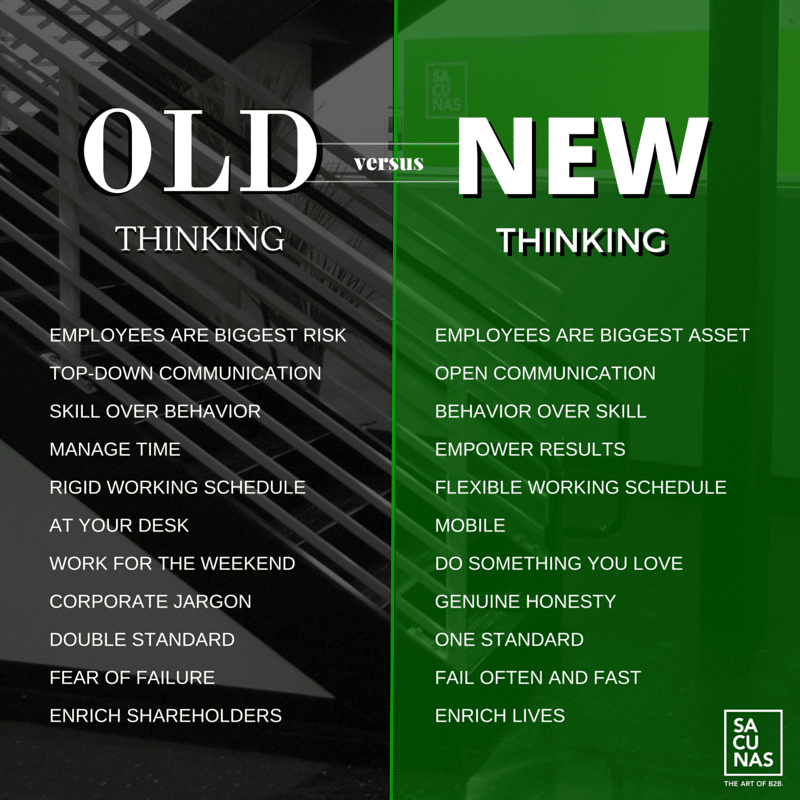I saw this image circulating around social media last week and I had to roll my eyes. It shows “new management thinking” on one column compared to “old management thinking” in the other.
It’s not because I don’t believe in the values of new management thinking. Quite the contrary. It’s that making the shift from old management thinking to new management thinking is not a problem to solve. It’s a polarity to manage.
A problem is something to be dealt with or overcome. A polarity, on the other hand, is something to be managed on a continuum. Basically, anytime you are dealing with things that seem at odds with each other or paradoxical, you’re dealing with a polarity and not a problem.
Take the first line in the viral image above as an example. Are employees your biggest risk or your biggest asset? The answer is both! Hire the wrong employee or lose control of your HR compliance function and it won’t be too long before you’re served a very expensive and frivolous lawsuit. On the other hand, if you treat your employees like they’re not your greatest asset — like they can’t be trusted to use their common sense or act in the best interest of the company — then you’re going to engender a lot of resentment and apathy.
This meme, which is generating thousands of likes and shares, portrays New Management Thinking as the solution to the problem of Old Management Thinking. It’s actually not the solution. There is no problem to solve – just a polarity to manage.
Don’t treat polarities as problems to be solved or pay the price. Why? Because when a team treats a polarity to manage as a problem to snuff out — chanting all the while “Down with hierarchy!” “Down with meetings!” “Out with the old and in with the new!” — one polarity will be emphasized too much and the organization will experience even bigger problems.
A team like this wastes an inordinate amount of time and energy on the wrong things, leading to a lot of activity and little effectiveness. Their misguided efforts also make it harder for the good and necessary aspects of the opposite polarity to exist within the organization. The end result is an organization that is less resilient and adaptable to change.
As a leader, being able to discern the difference between a problem and a polarity will help you to build a culture that makes the right decisions about the right things. This is true even if, from an uneducated eye, those efforts can sometimes appear to be in support of “old” ways of thinking. But they are not old ways of thinking! You are just boosting up an aspect of a polarity that is needed in your organization at this period in time. Later on, you may boost up “new” ways of thinking, depending again on what’s really needed. Let’s see how to do that…
Polarity Mangement
 There’s a book I like that does a good job of recognizing the difference between a polarity and a problem and how to leverage the best aspects of both sides of a polarity. The book is appropriately titled Polarity Management, by Barry Johnson.
There’s a book I like that does a good job of recognizing the difference between a polarity and a problem and how to leverage the best aspects of both sides of a polarity. The book is appropriately titled Polarity Management, by Barry Johnson.
In a picture, polarity management works like this. Draw a 2X2 matrix and put the poles or the extremes of the two polarities on the horizontal axis as Pole A and Pole B. Write “Positives” at the top of the vertical axis and “Negatives” at the bottom. Then identify in the top quadrants the positives of each pole and in the bottom note the negatives that come from an overemphasis of either pole. Finally, draw some butterfly wings that meet in the center of the quadrants with arrows in the left wing going counter-clockwise and arrows in the right wing going clockwise, to show the flow between polarities.
Going back to the meme that started this article, a polarity map of “old management thinking” vs. “new management thinking” would look something like this:
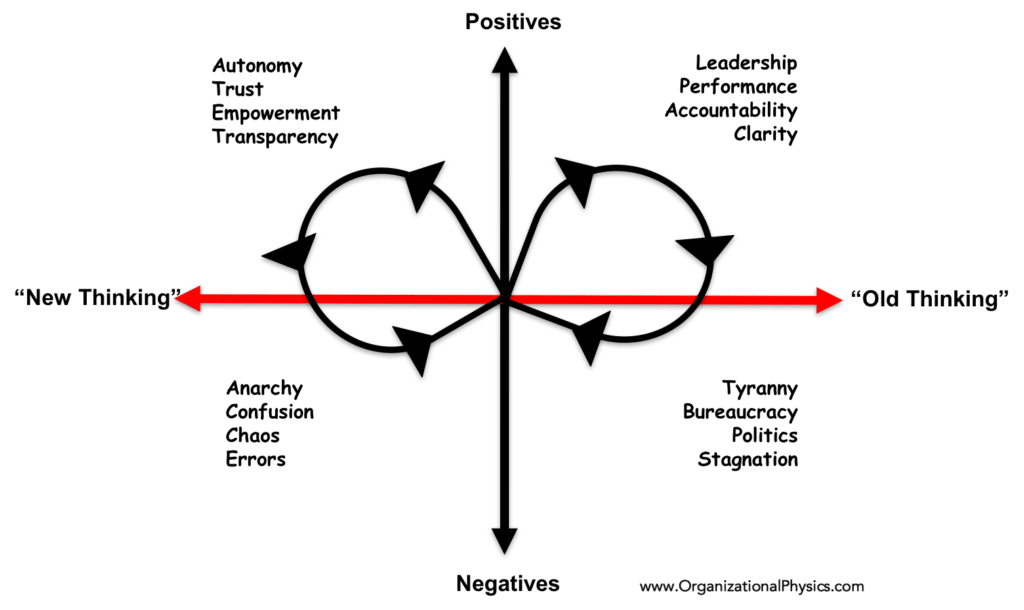
What does this map tell you? As a leader, your goal is to manage the polarity. This means leveraging the best of old management thinking and new management thinking while avoiding the extremes of both. If you find that the organization has emphasized one polarity too far, then you know you need to bring it back the other way by driving the organization towards the top of the other polarity.
In this example, if you found that your organization was too chaotic, free-wheeling, or producing too many errors (the negatives of new management thinking), then you know you need to add a bit more clarity, accountability, leadership, and performance management to bring it back the other way (the positives of old management thinking).
On the other hand, if you noticed that your organization was too bureaucratic, political, or stagnant (the negatives of old management thinking), then you’d need to break some glass and shift the organization’s polarity up the other side to have more transparency, autonomy, and trust (the positives of new management thinking).
The goal of polarity management is to be astute enough as a leader to get the positive sides (above the red horizontal line) of both polarities while avoiding the negative sides (below the red line) of each one. Put another way, you’re seeking to balance the organization so that it’s on the top half of the red horizontal line and doesn’t fall off into an abyss on either side.
OK, that makes a lot of sense in theory. However, sometimes it can be challenging to break a situation down into just two polarities. Life and work are messy and complicated. What is the polarity you are really dealing with? It can be hard to tell.
The good news is that if you like the principles behind Polarity Management but seek an easier “map” that tells you what you are really dealing with, you will find my Organizational Physics model very useful. The model can make recognizing and managing polarities in your organization much easier. Here’s what you need to know…
Organizational Physics and Polarity Management
When I set out to create Organizational Physics, one of my primary goals was to identify the underlying patterns that drive all organizational behavior and show how to improve performance. You can think of Organizational Physics as an ultimate meta-framework. It explains all other management theories (at least the good ones) and puts the different camps in their respective context. So naturally, Organizational Physics is rich with polarities.
Some of the main polarities within Organizational Physics include the dynamic tension between the need to be well integrated with the surrounding environment while managing things falling apart (Universal Success Formula). There’s also the polarity between organizational development and stability (Lifecycle Strategy). And there’s the polarity between making good decisions and implementing them fast (The Physics of Fast Execution).
However, one of the best parts of Organizational Physics is that once you understand the framework, it makes managing your organization much easier and even allows you to anticipate what happens next in its development. In this regard, understanding the Four Forces of Management – Producing, Stabilizing, Innovating, and Unifying — within Organizational Physics is not only useful, it’s the ultimate polarity management framework.
The principle behind the four forces of management – Producing, Stabilizing, Innovating, and Unifying — is that every complex adaptive system, from an individual to the world’s largest company, must at a minimum do four basic things. It must shape its environment and respond to change and it must manage its entire system, including the parts or tasks that make it up. In a picture, this means that at a fundamental level every system is managing these two basic sets of polarities between shape/respond and whole/parts:
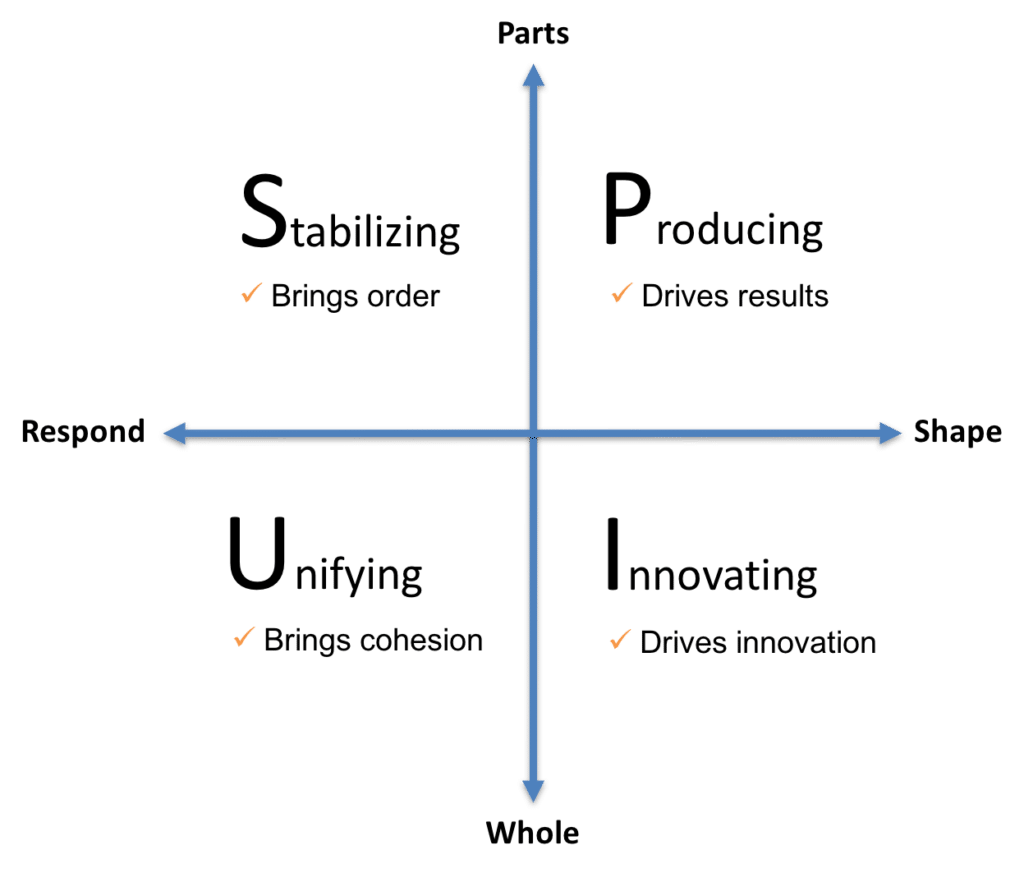
- The Producing Force is what gives an organization its drive to produce results for clients.
- The Stabilizing Force is what brings order and repeatability to the organization.
- The Innovating Force is what gives an organization its drive to find creative solutions and new ways of doing things.
- The Unifying Force is what brings cohesion and unity to the organization.
The picture below shows how each force or polarity has a different time horizon, approach, pace, and orientation. If this image doesn’t make much sense to you yet, you can learn more about each force and what it does in Part II of Organizational Physics or play around with the World’s Fastest Personality test and see how these forces show up in individual personality styles.
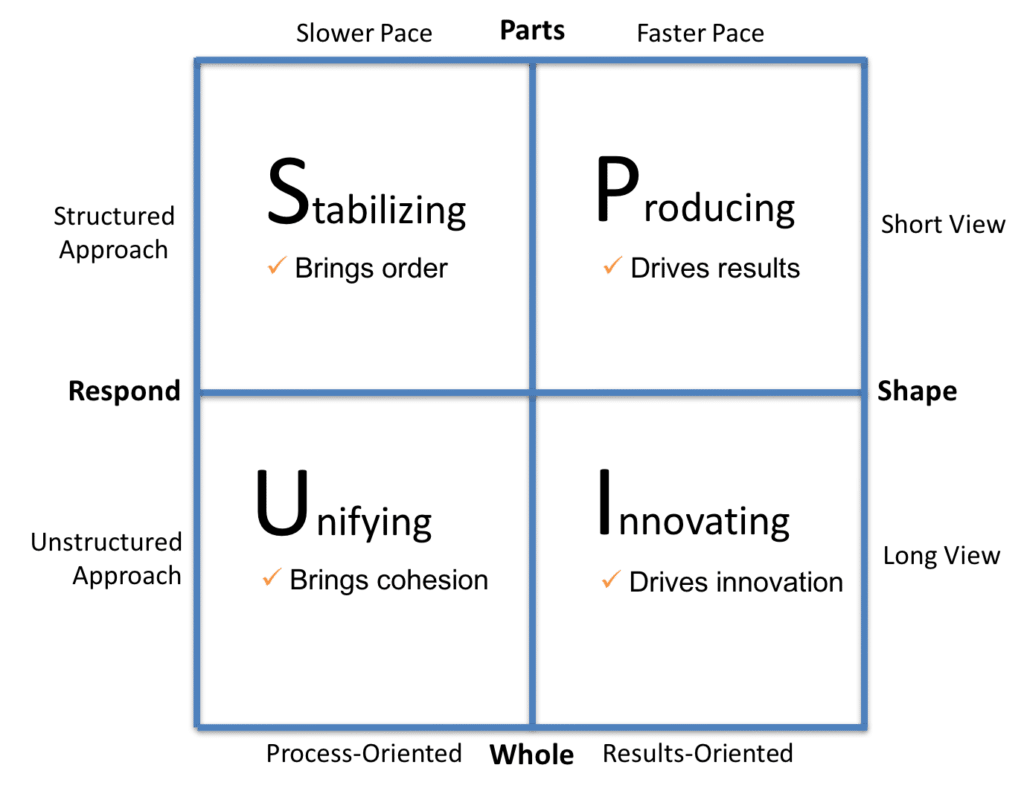
*** Please note that this image above has NOTHING to do with the four quadrant approach from the book Polarity Management. That is, that book shows how to break a polarity down into two dimensions. I’m going to show that most polarities can be understood across four dimensions total. This means that there is no horizontal red line above which you are trying to manage. Put another way, I am NOT saying that the Stabilizing and Producing forces are the positives and the Unifying and Innovating are the negatives. Quite the contrary, what this new vision means is that you are seeking to get the best of all polarities for the lifecycle stage of your system.***
Because, at any given point in time, every system must manage these polarities with finite energy, when one pole is really strong, another will be weak. In other words, the system will exhibit some tell-tale, predictable behaviors. Here’s how you can use that knowledge to your advantage…
Polarity Management Made Simpler
Once you understand that every organization is managing these four polarities — Producing, Stabilizing, Innovating, and Unifying — it’s much easier to place any set of polarities in their proper context and have a deeper sense of what to do next to improve organizational performance. Put another way, once you understand this framework, you have four dimensions to engage in polarity management vs. just two. Here’s what your new map looks like:
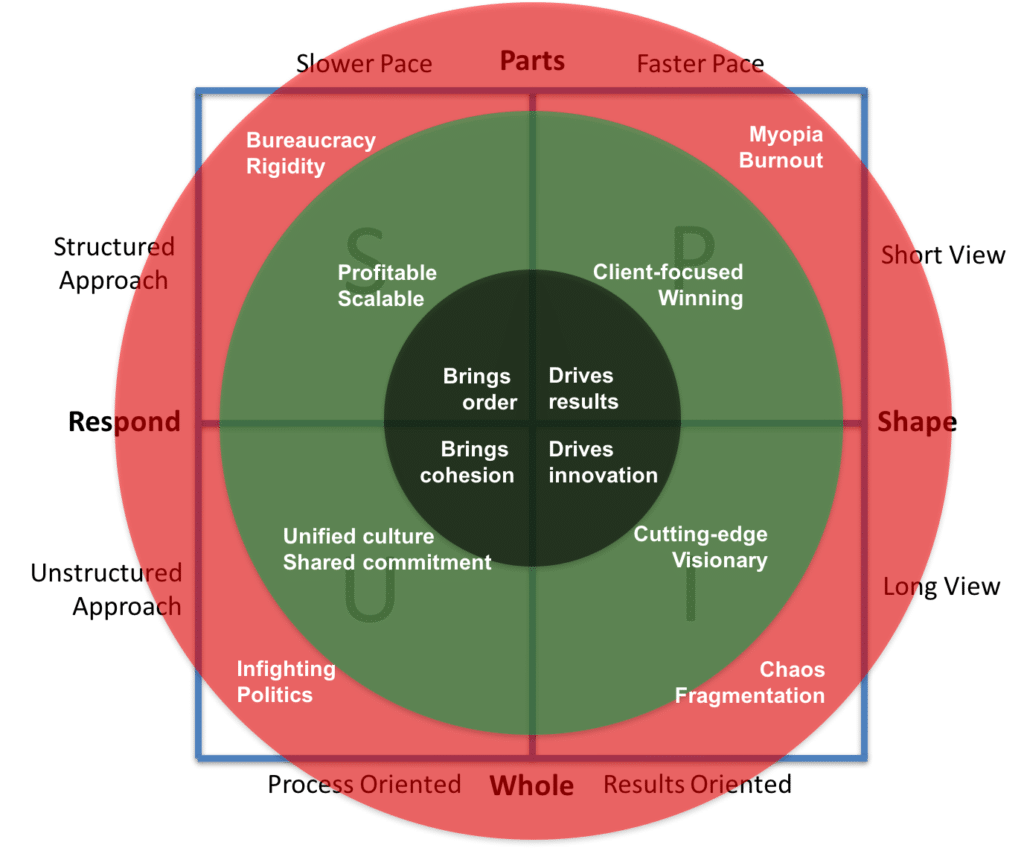
What this map shows is that a healthy, high-performing organization will have the right mix of forces for its lifecycle stage, as shown in the dark and light green circles. But push one polarity too far or at the wrong time to the red ring of the target and your organization will start to exhibit some negative, counterproductive behaviors. It’s a lot like driving a car. You’re trying to keep the engine humming by having the right mix of fuel and performance without taking one polarity too far (into the red) or you’ll burn out the engine.
What’s cool and useful about the above map is that you can use it to scan your organization and get a quick sense if one or more forces are too far out of whack. Then based on this awareness you can give the system more of the missing force, which will bring the organization back more towards the center of the target. Most situations you’ll come across in both work and life will fit somewhere on the above map!
For instance, if you were to notice that part of your organization can’t see the forest for the trees or is close to burnout from the constant short-range time pressure, you will see that the Producing force is out of balance in the upper right quadrant.
What should you do? Well, it would depend, of course, but using this map you would know you need to back off the Producing force and focus your efforts in one of the other areas first. You could add some more Stabilizing force to the system (through a better process or tools that reduce the workload); you could boost up the Innovating force (clarifying the strategy and big picture with the team); or you could focus on increasing the Unifying force (connecting and processing together as a team to reflect, renew, and recommit). Or some combination of these.
Going back to the first scenario that started this article, let’s say that an employee says to you, “We need more New Management thinking vs. Old Management thinking.” With this new map you can quickly ascertain that they are likely saying that the organization needs to develop its Unifying and Innovating forces (the bottom half of the map) over its Stabilizing and Producing Forces (the top half of the map). But you also know by now that this is not a problem to solve – it’s a polarity to manage without taking things too far in one direction.
Or, if your board member argues that the company needs to improve its sales process because it’s not scalable, you know that they are oriented towards the Stabilizing quadrant. While you might boost up the Stabilizing force with more focus on process and systems, you wouldn’t let it go too far out of whack so that the process takes over and the sales team loses its Producing force because it’s trapped in a bureaucracy.
One more example — your spouse tells you that you are working too much. What does this mean? He or she wants you to Unify more with the family. Is this a problem to solve? Nope. You get it. It’s a polarity to manage! So because your marriage and family are important to you, this coming weekend you’ll back off of your Producing force, put down your phone, and invest some quality time Unifying with the family. Everything is a trade-off and the basic idea is to not let one force get too out of balance for too long or you’ll suffer the (predictable) consequences. Instead, strive to manage the polarities and avoid the extremes.
One thing to keep in mind as you navigate the polarity map above is that if one force or pole is too far out of balance, you don’t add more energy and effort to improving that pole! Instead, you give energy and effort to its complementary pole. For instance, if your culture had turned toxic and there was a lot of infighting (an imbalance in the Unifying force), you would NOT take the team into a feel-good kumbaya team-building session. This is just adding more fuel to an over-hot Unifying force.
Instead, you would look to boost up one of the other three complementary forces depending on the needs of the organization. To boost up the Stabilizing force, you might bring more process or regimen to how the team interacts. To boost the Producing force, you might identify a big market challenge to get the team to focus more on external client needs and creating new client wins instead of internal politics. Alternatively, you might work with the team to align around a new vision and strategy — something that transcends petty politics — which would boost up the Innovating force.
In summary, if your company starts to treat a polarity as a problem to snuff out, it’s going to have a host of even bigger problems. Instead, try to recognize the general Producing, Stabilizing, Innovating, or Unifying quadrants that the organization’s current behavior is coming from. If it’s getting too far out of balance in one area, back off that area while boosting up another force. This will help to bring the organization back towards balance. Extremes will happen naturally, so your job as a leader is managing them to leverage the best that healthy polarities have to offer.
